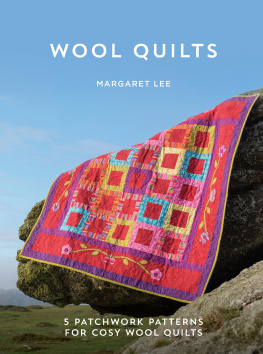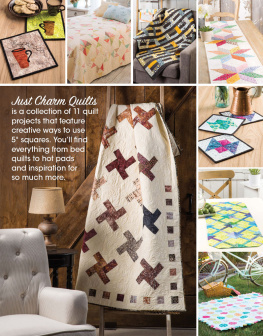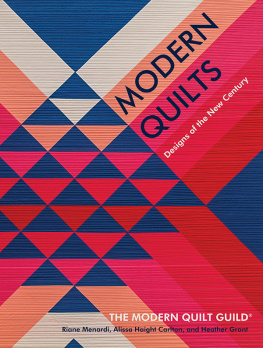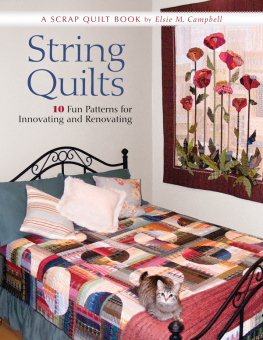Publisher: Amy Marson
Creative Director: Gailen Runge
Art Director/Book Designer: Kristy Zacharias
Editor: Lynn Koolish
Technical Editors: Debbie Rodgers and Gailen Runge
Production Coordinator: Rue Flaherty
Production Editor: Alice Mace Nakanishi
Illustrator: Valyrie Gillum
Photo Assistant: Mary Peyton Peppo
Style photography by Nissa Brehmer and instructional photography by Diane Pedersen, unless otherwise noted
Published by Stash Books, an imprint of C&T Publishing, Inc., P.O. Box 1456, Lafayette, CA 94549
DEDICATION
For Attila.
ACKNOWLEDGMENTS
The generosity of many made these quilts possible. Sincere thanks are extended to Michael Miller Fabrics, sole provider of all the solids and many of the prints used in the quilts; to Andover Fabrics for all the shirtings; and to Cloud 9, Windham, Westminster, and Moda Fabrics for more luxurious material. All batting was provided by Pellon/Legacy. Every millimeter of thread was supplied by Sulky; thank you for all those colors. Big love to all facets of Team Quilty. To the Quilty and Love of Quilting fansyou are even more fabulous than the quilts you make.
Thank you to Ebony for bailouts, longarm magic, and friendship. Special thanks to Heather Kinion, patchworker extraordinaire, who contributed many hours of piecing to Northbound, Forest Preserve, The Royal We, Rum Raisin, My Dear, Devotee, and Embers, all of which would never have been done in time were it not for her expert skills and grace. Thank you to Luz Martinez, Sally Evanshank, and LuAnn Downs for helping hands. Hannah and Biccy, you are my jumping bunnies. Mama, you are pure gold; thanks for knowing how (and for all that binding).
Thank you to Joe for everything and to the rest of the human race for everything else.
Mary Fons makes quilts exclusively and enthusiastically on BabyLock sewing and quilting machines.
INTRODUCTION
There are many ways to show and share love: cooking a meal for someone, writing a poem for him or her, taking a long walk, laughing, singing, planning (or plotting), goofing offthese are all ways we show love in our lives. We show love when we live beautifully, alone or together, doing our absolute best.
These quilts are for all the ways we show and share love in our lives; they are quilts for all of our days.
In a world teeming with objects accidentally beautiful, aggressively not beautiful, and forgettable, quilts fall into an exceptional category: Quilts are functional and beautiful and they are made on purpose. Quilts are functional art.
A great painting is made on purpose and may function to make you feel awestruck or inspired. A piece of music may move youit is functional in this regard. But what work of art can you literally wrap around your shoulders when youre sad? What work of art can physically warm you? What work of art pools, folds, props up, and lies flat; can be washed, dried, cried on, and repaired; and is the first thing anyone grabs when the house is on fire? What other work of art can you make love under?
Quilts are art you can flop on top of with a dish of ice cream and your beloved. (Or just the ice cream. Or just the beloved.) These objects are workaday, household necessities and precious artifacts at the same time. Whether a person particularly likes a given quilt or not, virtually everyone understands and respects the value a quilt has to its owner.
Human beings love quilts because quilts are objects of love; indeed, most quilts are made and given to someone as a gift. Just as love is not selfish, neither are quilters. A quilt is a physical manifestation of the sentiment, You are cared for. I want you to be warm and dry. If youre really lucky, a quilt can mean, Without question, I love you.

NOTES ON THIS BOOK
BIG, BIGGER, BIGGEST
Quilters are impatient people.
To a nonquilter, this seems almost laughably wrong. Arent quilters gentle, steady folk, content to stitch all afternoon in a rocking chair? Not only is this impression incorrect with regard to quilters in the pastearly American quilters hardly had leisure timeits untrue today. Dedicated quilters are foot-tappers, forever on the lookout for ways to get quilts done more quickly and efficiently for one simple reason: we want to make our next quilt as soon as possible.
Because of this impatience (we think of it as passion), and because were awfully busy otherwise, there is significant interest in whats called the small project. Wallhangings, pillows, baby quilts, and table runners are all small sewing projects that satisfy a quilters innate impatience; many of these projects can be completed in a single day.
The quilts in this book not so much. These quilts are big. Depending on how frequently you get to your sewing machine, these quilts may take you some time to complete. Unless you know something I dont, they will stubbornly refuse to be finished in a day.

These quilts are designed for beds, and your bed is probably queen- or king-size. A queen-size mattress in the United States measures approximately 60 80, a king-size, 76 80. Quilts are meant to drape over a bed, not just sit on top of it, so a quilt for an adult-sized bed needs to measure anywhere from 88 90 to 90 100 or bigger, depending on the size of the people who will use it.
For those who want a quick quilt fix, this book will make an excellent coaster. But I urge even the most impatient of quilters to consider taking on a large quilt. The quilts that take our breath away at shows and exhibits are the big ones. In terms of color and pattern, whats good in a small quilt is stunning in a big one. When you see a bedroom with a generous quilt on the bed, you marvel and cooscale is powerful. Its also practical. Big quilts are body-sized, comfort-sized. No one wants their feet sticking out the bottom of the covers. Besides, you cant make love under a table topper.
SCRAP LOVE
Aside from being large, the quilts in this book can be classified as scrap quiltsthey are made from many different fabrics.
There are as many different kinds of quilts in the world as there are quilters, including some people who make quilts using approximately four to six fabrics, frequently from a single line within a manufacturers collection. There is nothing wrong with this approach. In fact, there are benefits to making quilts with only a handful of fabrics from a new lineits faster, youre unlikely to have color or contrast surprises, and youre sure to be on trend.
Scrap quilts, at least the way I approach them, are a different animal. There will always be surprises, accidents, and problems to solve. It cannot be denied: Making extremely scrappy quilts takes more time than making quilts with a small number of fabrics. Notwithstanding the time it takes to select the scraps themselves (this will take some significantly longer than others), youll have to iron, cut, and sort or otherwise organize every piece.
But the extra work is worth it. Intelligently scrappy quilts have a depth and a beauty hard to achieve with a six-fabric quilt. The six-fabric quilt will have its charm, but I like dozens and dozens of fabrics playing together. Theres a surprise in every block. Every quilt becomes a charm quilt; every quilt is head-slappingly unique. This is a great joy for a quilter and can assuage the pain of early arthritis brought on by hours at the cutting mat.
Whenever I get antsy about finishing my cutting, whenever I start feeling done with a quilt before Ive finished joining rows, I stop and ask myself why Im making the quilt in the first place. You might ask yourself the same thing. Hopefully, our goal is the same: We want to create a functional object of beauty and be proud of an accomplishment. Hopefully, we make quilts because we want to show someone loveand that person might be you, yourself. So turn on the radio and enjoy the scrap quilt process. Yes, it takes a long time to make a big scrap quilt, but so what?
Next page














